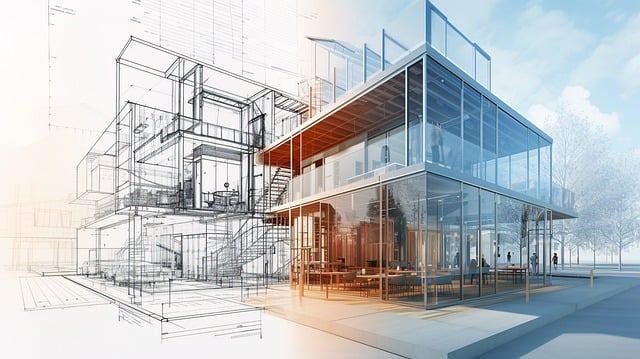Drafting involves technical drawing of plans, while architecture encompasses design, planning, and construction of buildings and structures.
When it comes to building design and construction, two terms that often come up are drafting and architecture. While they are related, there are key differences between the two that are important to understand. In this article, we will explore the distinctions between drafting and architecture, including educational requirements, job descriptions, services offered, and fees.
Architectural drafting is an integral part of the architectural design process. It involves creating detailed technical drawings and plans that serve as a blueprint for construction. Draftsmen, also known as draftspersons, specialize in producing these drawings using computer-aided design (CAD) software.
On the other hand, architecture is a broader profession that encompasses multiple stages of a building project. Architects are highly trained professionals who not only design buildings but also oversee their construction. They are involved in the planning, design production, and construction supervision phases of a project.
Key Takeaways:
- Architectural drafting involves creating detailed technical drawings, while architecture encompasses the overall design and construction process.
- Draftsmen use CAD software to produce drawings, while architects have a more comprehensive role in project management.
- Architects undergo extensive education and training, including a master’s degree in architecture, while draftsmen typically complete a two-year course in drafting.
- Architects offer comprehensive services throughout a project, while draftsmen often work under architects and focus on drawing plans.
- Architectural services are usually more expensive than drafting services, and architects have higher earning potential.
Job Description Differences between Architect and Draftsman
When it comes to the job description, architects and draftsmen have distinct roles in the field of architecture. Architects are involved in various stages of a project, from early consultation to construction supervision. On the other hand, draftsmen mainly focus on concept sketches and plans, with limited involvement in the construction process.
Let’s take a closer look at the job descriptions of architects and draftsmen:
Architect

As highly trained professionals, architects have a broad range of responsibilities throughout a project. They play a vital role in the planning and design production, ensuring that the building meets the client’s requirements and adheres to safety and regulatory standards. Architects also evaluate bids from contractors and oversee the construction process to ensure the project’s successful completion.
Draftsman

Draftsmen, on the other hand, specialize in creating concept sketches and plans based on the architect’s design. They are proficient in using computer-aided design (CAD) software to draft accurate technical drawings. While their contribution is essential in visualizing the architect’s vision, draftsmen typically have limited involvement beyond the planning stage.
Here’s a comparison of the job responsibilities between architects and draftsmen:
| Architect | Draftsman |
|---|---|
| Consultation with clients | Concept sketching |
| Planning and design production | Technical drawing creation |
| Bid evaluation | – |
| Construction supervision | – |
As seen in the table, architects have a broader scope of responsibilities compared to draftsmen. Their involvement spans multiple stages of the project and requires a comprehensive understanding of the architectural profession.
Now that we’ve explored the job description differences between architects and draftsmen, let’s move on to their education and training in the next section.
Education and Training Differences between Architect and Draftsman
The architectural profession requires both architects and draftsmen to undergo specific education and training to develop their skills and expertise. Understanding the differences in education and training is essential for aspiring professionals and individuals seeking architectural services.
Architect Education and Training
Architects go through an extensive educational journey that equips them with the necessary knowledge and competencies to excel in their profession. Here is a breakdown of the education and training requirements for architects:
- Bachelor’s Degree in Architecture: Architects typically begin their academic journey by obtaining a bachelor’s degree in architecture. This undergraduate program provides a solid foundation in architectural theory, design principles, and technical skills.
- Master’s Degree in Architecture: After completing their bachelor’s degree, aspiring architects usually pursue a master’s degree in architecture. This advanced degree allows them to delve deeper into complex architectural concepts, develop critical thinking abilities, and gain practical experience through internships or cooperative education programs.
- Practical Experience: In addition to formal education, architects are required to gain practical experience through internships or apprenticeships. This allows them to apply their theoretical knowledge in real-world architectural projects and learn from experienced professionals in the field.
Draftsman Education and Training
Draftsmen, also known as architectural drafters, typically follow a more specialized educational path. Their education and training focus on developing proficiency in computer-aided design (CAD) software and technical drafting skills. Here are the key aspects of education and training for draftsmen:
- Two-Year Course in Computer-Aided Design: Draftsmen commonly complete a two-year course that emphasizes CAD software and technical drawing techniques. This program equips them with the skills needed to create accurate and detailed architectural plans and drawings.
- Specialized Training: Alongside their formal education, draftsmen may also undergo specialized training in specific CAD software or industry-specific drafting techniques. This helps them enhance their efficiency and expertise in producing architectural drawings.
The educational paths for architects and draftsmen differ in terms of duration, depth of knowledge, and skill focus. Architects undergo a more extensive educational journey, including both bachelor’s and master’s degrees, while draftsmen typically focus on a shorter, more specialized course aimed at developing CAD and technical drafting skills.
Services Offered by Architect vs Draftsman
Architects and draftsmen provide distinct services in the field of architecture, each serving a unique purpose in the design and construction process. Understanding the services offered by these professionals can help you make an informed decision when deciding who to hire for your project.
Architectural Services
Architects offer comprehensive services that cover various stages of a building project. Their expertise extends from the initial concept and design phase to the final construction and completion. Here are some of the key services that architects provide:
- Consultation and client meetings to understand project requirements
- Site analysis and feasibility studies
- Conceptual design and space planning
- Preparation of construction drawings and specifications
- Obtaining necessary permits and approvals
- Collaborating with engineers and other professionals
- Construction administration and site supervision
- Post-construction evaluations and inspections
Architects bring a wealth of knowledge and expertise to ensure that your project meets legal and safety requirements, while also delivering a functional and visually appealing design.
Draftsman Services
Draftsmen, also known as architectural drafters, focus primarily on translating design concepts into detailed technical drawings. Their services are often employed through architecture firms or under the supervision of architects. Here are the primary services offered by draftsmen:
- Creating accurate and precise construction drawings based on architectural designs
- Generating 2D and 3D models using drafting software
- Preparing floor plans, elevations, and sections
- Producing detailed drawings for construction purposes
- Collaborating with architects and engineers to ensure coordination
Draftsmen play a crucial role in translating the architect’s vision into technical drawings that can be used by contractors and builders during the construction phase.
While both architects and draftsmen contribute to the design and construction process, their roles and responsibilities differ. Architects provide comprehensive services and can be held legally accountable for their work, while draftsmen focus on specific tasks related to technical drawings and plans.
When choosing between an architect and a draftsman, it’s important to consider the complexity of your project, your budget, and the level of involvement you require. Architects are a suitable choice for large, intricate projects that require extensive planning and coordination. On the other hand, draftsmen may be more cost-effective for smaller-scale projects where design complexities are minimal.
Cost/Fees Differences between Architect vs Draftsman
When it comes to hiring professionals for your architectural project, one key aspect to consider is the cost or fees associated with architects and draftsmen. The fees charged by these professionals can vary significantly, so it’s important to understand the differences before making your decision.
Architects typically have a percentage-based fee structure, which is calculated based on the total build cost of the project. The percentage can range from 8% to 15% for full services. This means that if your project costs $500,000, you can expect to pay between $40,000 and $75,000 in architectural fees.
On the other hand, draftsmen usually charge lower percentage fees, typically ranging from 1% to 3% of the total build cost. So for a $500,000 project, the fees for a draftsman would be around $5,000 to $15,000.
Let’s take a closer look at the average costs per project for architects and draftsmen:
| Professional | Average Cost per Project |
|---|---|
| Architect | $5,000 |
| Draftsman | $1,800 |
As you can see from the table above, the average cost per project is higher for architects compared to draftsmen. This difference in cost is primarily due to the level of expertise and the comprehensive services offered by architects throughout the entire project.
It’s important to note that these cost figures are just averages and can vary depending on various factors such as the complexity of the project, the location, and the scope of the services required.
Ultimately, when deciding between an architect and a draftsman, it’s crucial to consider your budget and the level of expertise you require for your project. While architects may have higher fees, they bring a broader range of skills, knowledge, and experience to the table. However, if you have a simpler project and are looking for more budget-friendly options, a draftsman may be a suitable choice.
Salary Differences between Architect and Draftsman
When considering a career in the architectural profession, it’s essential to understand the salary differences between architects and draftsmen. The salary discrepancy reflects the variance in roles, responsibilities, and qualifications between these two positions.
Architects: Architectural professionals who have completed extensive education and training typically earn higher salaries compared to draftsmen. Entry-level architecture positions start at approximately $110,000 per year, while established architects can make up to $177,000 per year. The earning potential for architects is influenced by factors such as experience, expertise, and location.
Draftsmen: On the other hand, the median salary for a draftsman is around $60,000 per year. Draftsmen generally focus on the creation of concept sketches and building drafts, with limited involvement in the overall architectural process. Their lower salary range is a reflection of their more specialized role within the profession.
The salary difference underscores the importance of the architect’s higher level of education, licensure, and comprehensive involvement in various stages of a project. Architects are not only responsible for the design and planning but also play a significant role in the construction supervision and ensuring compliance with regulatory standards.
The table below provides a summary of the salary differences between architects and draftsmen:
| Position | Salary Range |
|---|---|
| Architect | $110,000 – $177,000 per year |
| Draftsman | Around $60,000 per year |
It is important to note that these salary figures are approximate and can vary based on factors such as experience, geographic location, and company size. However, they provide a general understanding of the earning potential in each respective role.
What is an Architectural Designer?
Architectural designers are important members of the architecture field. They work closely with architects and design firms, helping to create and document architectural projects. Even though they’re not fully qualified architects, they still play a vital role in the design process, using their education and training to contribute to architectural designs and plans. While their qualifications can vary, they all have a good grasp of architectural principles.
These designers collaborate closely with architects and other team members, sharing their insights and ideas to bring project visions to life. Although they may not have as much expertise as licensed architects, their unique skills complement the work of architects, ensuring that projects run smoothly and successfully.
Role of an Architectural Designer
The role of an architectural designer can vary depending on the specific project and the design firm they work for. However, some common responsibilities include:
- Collaborating with architects and design teams to develop design concepts
- Creating architectural drawings and renderings
- Assisting in the selection of materials and finishes for projects
- Conducting research on architectural trends and best practices
- Presenting design proposals to clients
Architectural designers bring their creativity, technical skills, and understanding of architectural principles to the design process. They help translate concepts into visual representations, contributing to the development of unique and functional architectural designs.
What is a Draftsperson?
Draftspersons are specialists in creating technical drawings and plans using computer-aided design and drafting software (CADD). Their main role is to turn sketches and hand drawings into detailed architectural drawings for construction purposes, ensuring accuracy and precision in their work. They’re highly skilled in using CADD software to translate design concepts into technical drawings that provide essential information for construction teams.
While some draftspersons may have formal education in drafting, it’s not always required for the job. Many gain their skills through practical experience and on-the-job training, becoming proficient in technical drawing and architectural drafting software. Their technical drawings play a crucial role in ensuring the efficiency and accuracy of the construction process, effectively communicating the design vision of architects and designers to construction teams, making draftspersons indispensable members of the architectural profession.
Key Responsibilities of a Draftsperson:
- Create detailed architectural drawings based on sketches and design concepts
- Utilize CADD software to accurately represent architectural designs
- Ensure compliance with building codes, regulations, and project specifications
- Collaborate with architects, designers, and construction teams to resolve any design or construction-related issues
- Create construction documentation such as floor plans, elevations, sections, and details
Skills Required for Draftspersons:
- Proficiency in computer-aided design and drafting software (CADD)
- Strong technical drawing skills
- Attention to detail and accuracy
- Understanding of building materials and construction techniques
- Ability to interpret architectural drawings and design concepts
| Skills | Description |
|---|---|
| CADD Proficiency | Expertise in using computer-aided design and drafting software to create technical drawings |
| Technical Drawing Skills | Ability to create accurate and detailed architectural drawings |
| Attention to Detail | Keen focus on precision and accuracy in drawing creation |
| Building Materials and Construction Techniques | Understanding of various construction materials and methods to ensure practicality in design drawings |
| Interpretation of Architectural Drawings | Capability to understand and translate design concepts into technical drawings |
A draftsperson’s technical skills and proficiency in creating detailed drawings contribute to the smooth execution of architectural designs. Whether working independently or as part of a larger team, draftspersons are instrumental in bringing architectural visions to life.
Abilities and Skills Differences between Architect, Designer, and Draftsperson
Architects, designers, and draftspersons each bring unique abilities and skills to the architectural profession. Their roles and responsibilities vary, but all contribute to the design, planning, and construction of buildings. Let’s explore the specific abilities and skills that differentiate these professionals:
Architect:
- Extensive education and experience in design and implementation
- Comprehensive understanding of how buildings come together
- Ability to coordinate and collaborate with various professionals
- Holistic approach to project management and problem-solving
- Proficient in creating innovative and sustainable design solutions
Designer:
- Similar design education and experience as architects
- Focused expertise in specific design concentrations, such as interior design
- Highly skilled in creating aesthetically pleasing and functional spaces
- Knowledgeable about materials, colors, and textures
- Ability to translate client needs and preferences into design concepts
Draftsperson:
- Specialization in documentation and delivery of architectural designs
- Expertise in turning designs into technical drawings for construction
- Proficient in using computer-aided design and drafting software (CADD)
- Attention to detail and accuracy in creating architectural plans
- Understanding of building components and construction techniques
While architects have a comprehensive understanding of design, implementation, and project management, designers bring creativity and specialized knowledge in specific design areas. Draftspersons excel in technical drawings and play a crucial role in translating design concepts into construction plans.
Overall, the architectural profession benefits from a diverse range of abilities and skills contributed by architects, designers, and draftspersons, ensuring the successful realization of architectural projects.
Choosing Between Architect, Designer, and Draftsperson
Choosing between an architect, designer, or draftsperson depends on factors like project complexity, design importance, and budget. Architects handle complex projects, offering comprehensive services from design to construction supervision. They’re ideal for intricate projects with detailed design needs.
For moderately complex projects with budget constraints, designers, especially those in interior design, are a good option. They offer innovative and functional design solutions similar to architects. Draftspersons are cost-effective for simple projects, specializing in technical drawings using computer-aided design software. They excel at turning design concepts into detailed construction drawings. When deciding, consider each professional’s design capabilities, expertise, and fees, and review their previous work to find the right fit for your project.
Considerations when Choosing a Design Professional:
- Project complexity: Evaluate the complexity of your project and determine whether it requires the expertise of an architect, designer, or draftsperson.
- Design capabilities: Assess the design capabilities of each professional based on their past work and portfolio. Look for examples that align with your project vision.
- Design fees: Consider your budget and compare the design fees offered by architects, designers, and draftspersons. Keep in mind that architects generally have higher fees due to their comprehensive services.
By carefully considering these factors, you can make an informed decision and choose the design professional that best suits your project’s needs.
The Importance of Design in Building Projects
Good design is essential for building projects as it can transform lives, improve functionality, and increase property value. Whether it’s a home or a commercial building, design impacts daily experiences and interactions.
Design professionals like architects, designers, and draftspersons are crucial for bringing ideas to life. Architects understand design principles deeply, while designers specialize in specific areas like interior design. Draftspersons are skilled in technical drawings, ensuring designs are implemented accurately. Investing in design ensures projects reach their full potential, enhancing functionality and aesthetics while increasing property value.
Conclusion
Drafting and architecture are distinct yet interconnected aspects of building design and construction. Architects, with their extensive education and training, provide comprehensive services throughout a project’s lifecycle. They are responsible for planning, designing, and overseeing construction to ensure client satisfaction and safety standards.
Draftsmen focus on the technical aspects of architectural design, creating detailed plans. While their role may be limited to the planning stage, their expertise is vital in turning concepts into tangible drawings. When choosing between architects, designers, or draftspersons, consider factors like project complexity and budget. Architects are suitable for complex projects, designers offer expertise in specific areas like interior design, and draftspersons are cost-effective for simpler projects needing technical drawings. Engaging a design professional ensures project success by bringing expertise and creativity to transform ideas into reality, meeting and exceeding expectations.
FAQ
What is the difference between drafting and architecture?
The difference lies in their educational requirements, job descriptions, services offered, and fees. Architects have a master’s degree in architecture and are involved in multiple stages of a project, while draftsmen typically complete a two-year course in computer-aided design and focus mainly on concept sketches and building drafts.
What are the job description differences between an architect and a draftsman?
Architects are involved in planning, design production, bid evaluation, and construction supervision, while draftsmen primarily focus on concept sketches and plans with limited involvement in the construction process.
How do the education and training differ between architects and draftsmen?
Architects must complete a bachelor’s degree and a master’s degree in architecture, along with practical experience, while draftsmen typically complete a two-year course in computer-aided design.
What services do architects offer compared to draftsmen?
Architects offer comprehensive services across multiple stages of a project, including planning, design production, and construction supervision. Draftsmen often work under architects and primarily focus on drawing plans and designs.
What is the cost/fee difference between hiring an architect and a draftsman?
Architectural services are usually more expensive than drafting services. Architects have a percentage-based fee structure, ranging from 8-15% of the total build cost, while draftsmen have lower percentage fees, usually around 1-3%.
What is the salary difference between architects and draftsmen?
Architects generally have higher salaries compared to draftsmen. Entry-level architecture positions start at approximately 0,000 per year, while the median salary for a draftsman is around ,000 per year.
What is an architectural designer?
An architectural designer collaborates with architects to create and document design projects. They have a degree in architecture or a related design concentration and can vary in skill level depending on education and experience.
What is a draftsperson?
A draftsperson specializes in creating technical drawings and plans using computer-aided design and drafting software. They focus on turning sketches and hand drawings into detailed architectural drawings for construction.
How do the abilities and skills differ between architects, designers, and draftspersons?
Architects have extensive education and experience in design and implementation, while designers may have similar design education and draftspersons specialize in technical drawings and delivery.
How do I choose between an architect, designer, and draftsperson?
The choice depends on the complexity of your project, the importance of design, and your budget. Architects are ideal for complex projects, designers can provide similar services, and draftspersons are a cost-effective option for simple projects.
How important is design in building projects?
Good design is crucial as it can transform lives, improve functionality, and increase return on investment. Design professionals play a vital role in turning ideas into reality.
Source Links
- https://www.architectureanddesign.com.au/features/list/architect-of-draftsman-how-to-tell-what-your-next
- https://yr-architecture.com/difference-between-an-architect-designer-drafter/
- https://careertrend.com/info-8587273-difference-between-drafting-architecture.html
Image Credits
Featured Image By – Vilius Kukanauskas from Pixabay
Image 1 By – mindandi on Freepik
Image 2 By – DC Studio on Freepik








